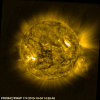
When observing the Sun for a prolonged period of time, it soon becomes evident that features on its surface, and in its outer atmosphere do not rotate at the same rate. This is because the Sun is not a solid body, but a big ball of magnetised plasma, whose rotation is variable with position and height in the solar atmosphere. One of the most striking observations is that of ‘differential’ rotation, where features on the solar surface and in the solar atmosphere are observed to rotate faster at the equator (rotation period = 25.4 days) when compared to those closer to the poles (rotation period = 36 days). This is evident in observations of sunspots, which have been used as tracers for measuring solar motion for many years.